Paper Menu >>
Journal Menu >>
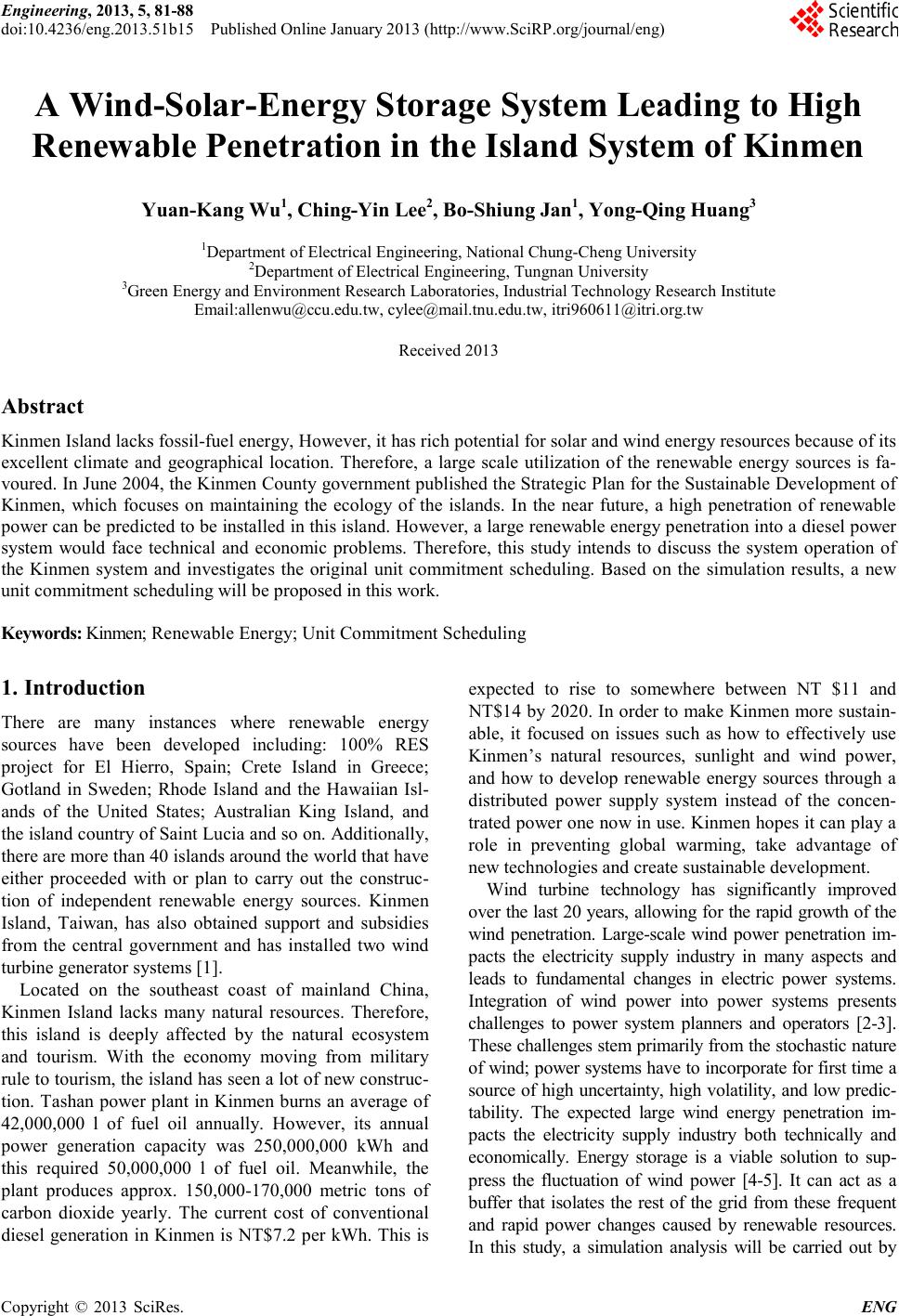 Engineering, 2013, 5, 81-88 doi:10.4236/eng.2013.51b15 Published Online January 2013 (http://www.SciRP.org/journal/eng) Copyright © 2013 SciRes. ENG A Wind-Solar-Energy Storage System Leading to High Renewable Penetration in the Island System of Kinmen Yuan-Kang Wu1, Ching-Yin Lee2, Bo-Shiung Jan1, Yong-Qing Huang3 1Department of Electrical Engineering, National Chung-Cheng University 2Department of Electrical Engineering, Tungnan University 3Green Energy and Environment Research Laboratories, Industrial Technology Research Institute Email:al len wu@ ccu.edu.tw, cylee@mail.tnu.edu.tw, itri960611@itri.org.tw Received 2013 Abstract Kinmen Island lacks fossil-fuel energy, However, it has rich potential for solar and wind energy resources because of its excellent climate and geographical location. Therefore, a large scale utilization of the renewable energy sources is fa- voured. In June 2004, the Kinmen Count y go vern me nt pub lis hed t he St rate gic Pla n for the Sust ainab le D evelo p ment o f Kinmen, which focuses on maintaining the ecology of the islands. In the near future, a high penetration of renewable power can be predicted to be installed in this island. Howeve r, a large renewable energy penetration into a diesel power system would face technical and economic problems. Therefore, this study intends to discuss the system operation of the Kinmen system and investigates the original unit commitment scheduling. Based on the simulation results, a new unit commitment sche duling will b e proposed i n this work. Keywords: Kinmen; Re newable Energy; Unit C ommitment Schedulin g 1. Introduction There are many instances where renewable energy sources have been developed including: 100% RES project for El Hierro, Spain; Crete Island in Greece; Gotland in Sweden; Rhode Island and the Hawaiian Isl- ands of the United States; Australian King Island, and the island country of Saint Lucia and so on. Additionally, there are more than 40 islands a round the world that have either proceeded with or plan to carry out the construc- tion of independent renewable energy sources. Kinmen Island, Taiwan, has also obtained support and subsidies from the central government and has installed two wind turb ine ge ne rator systems [1]. Located on the southeast coast of mainland China, Kin me n Island lacks many natural resources. Therefore, this island is deeply affected by the natural ecosystem and tourism. With the economy moving from military rule to touris m, the island has seen a lot of new co nstr uc- tion. Tashan power plant in Kinmen burns an average of 42,000,000 l of fuel oil annually. However, its annual power generation capacity was 250,000,000 kWh and this required 50,000,000 l of fuel oil. Meanwhile, the plant produces approx. 150,000-170,000 metric tons of carbon dioxide yearly. The current cost of conventional diesel generation in K inmen is NT$7.2 per kWh. This is expected to rise to somewhere between NT $11 and NT$14 by 2020. In order to make Kinmen more sustain- able, it focused on issues such as how to effectively use Kinmen’s natural resources, sunlight and wind power , and how to develop renewable energy sources through a distributed power supply system instead of the concen- trated p ower o ne no w in use. Kinmen ho pe s it c a n pla y a role in preventing global warming, take advantage of new technolo gies and create sustainable developmen t. Wind turbine technology has significantly improved over the last 20 years, allo wing for t he rapid growth of t he wind penetration. Large-scale wind power penetration im- pacts the electricity supply industry in many aspects and leads to fundamental changes in electric power systems. Integration of wind power into power systems presents chall enges to power system planners and operators [2-3]. These challenges stem primarily from the stochastic nature o f wi nd ; power syste ms have to i ncorpo rate fo r first time a source of high uncertainty, high volatility, and low predic- tability. The expected large wind energy penetration im- pacts the electricity supply industry both technically and economically. Energy storage is a viable solution to sup- press the fluctuation of wind power [4-5]. It can act as a buffer that isolates the rest of the grid from these frequent and rapid power changes caused by renewable resources. In this study, a simulation analysis will be carried out by  Y.-K. WU ET AL. Copyright © 2013 SciRes. ENG 82 adding energy storage systems to the hi gh wind penetration system in Kinmen. The interconnection of large amount of renewable gen- eration resources would result in a lower amount of inertia on the electric system and a potential frequency control problem [6-8]. That is, if more synchronous machines are displaced by wind generation, the system inertia will de- crease, making the power s ystem more sensitive to genera- tion-load imbalances. Generally, the small size and lack of external support of isolated power systems could result in severe voltage dips due to disturbances and frequency sta- bility issues [9-10]. The weaker is the system the larger and are longer voltage dips. Additionally, in isolated systems with high renewable energy penetration, they have low inertia constant and insufficient primary frequency regula- tion; therefore, frequency stability issue should be taken care. In this work, the development strategies of renewable ener gy sources and future renewable energy planning in Kinmen will be introduc ed. Additionally, system impacts of large-scale integration of renewable energy in Kinmen and corresponding system simulation analyses are imple- mented in this study. Finally, a revised unit commitment scheduling in Kinmen system is proposed. 2. The Devel opment St rategies of Renewab le Energy Sources in Kiemen 2.1. Current Electricity Power System of Kin- men Island The power system in Kinmen area is a typical islanding system with the highest voltage rating at 22.8kV. Kin- men Power Company constructed a new power plant at Tashan and also expanded the electricity capacity of Xiaxing power plant already in use. Therefore, today, Kinmen Island has two po wer plants. It can be divided into Tashan and Xiaxing thermal power plants, Jins a wind parks, Tashan, Juguang, Qushan, and Xiaxing substations. Tashan thermal power plant has phase 1 and phase 2 diesel generator units, including 4 diesel genera- tor units for phase 1 with an installed capacity of 7.91 MVA for each unit and 4 diesel generator units for phase 2 with an installed capacity of 8.25 MVA for each unit. Therefore, the total installed capacity of thermal power plants is 84.94 MVA. These 8 diesel generator units are grid connected through the 13.2kV/22.8kV step-up transformers. Ea c h gener a to r unit has t wo co ntr o l mod es : droop and isochronous controls. For the two Type-C wind power generator units in Jinsha wind park, each unit has a rated output of 2MW. After the step-up trans- former to convert the voltage to 11.4KV, each set of four units is connected to the bus of Qushan substation. The single line diagram of the whole Kinmen system is sho wn in Fig.1. Figure 1 Single line diagram of the Ki nme n system 2.2. Survey and Analysis regarding the Potential for Renewable Energy Sources The climatic statistic data for Kinmen region during 2004 to 2012 is shown in Table 1. In recent years, sun- light duration in Kinmen has averaged 154.77 h per mont h. This i s hi gher tha n p a s t r ec o rd s whic h ind ic ate a n average of 138.8 h per month. In fact, the monthly aver- age sunlight duration in July and August is over 200 h and can sometimes reach up to 251.49 h. I n Kinme n Ju l y and August have the longest sunlight duration and also have the highest temperatures. Thus, it might seem that Kinmen has optimum conditions for the development of solar energy, whether that be solar PV systems or solar thermal water heater systems. The wind fro m June to August in Kinmen is from the southwest while in winter months it blows from the northeast. In recent years, the maximum 10 min wind speed has ranged from 8.29 m/s to 12.24 m/s. The max- imum instantaneous wind speed has ranged from 16.8 m/s to 31.9 m/s. Most winds blow from the ENE, NE, and N directio ns. Based o n the statistical d ata fr om Table 1, Kinmen Island is also suitable for the development of wind power generation systems to replace concentrated po wer plants. 2.3. Current Protection Scheme in Kinmen Power System The under-frequency load shedding scheme is currently used in Kin men to prevent incidents fr om caus i ng system crashes and blackout; its detail is s ho wn in T able 2. Tai- wan Power Company (TPC) uses automatic under-fre - quency load shedding relays on the feeders at Tashan and Xiaxing substations as the main power defense strategy for Kinme n’s power system. The sheddi ng op 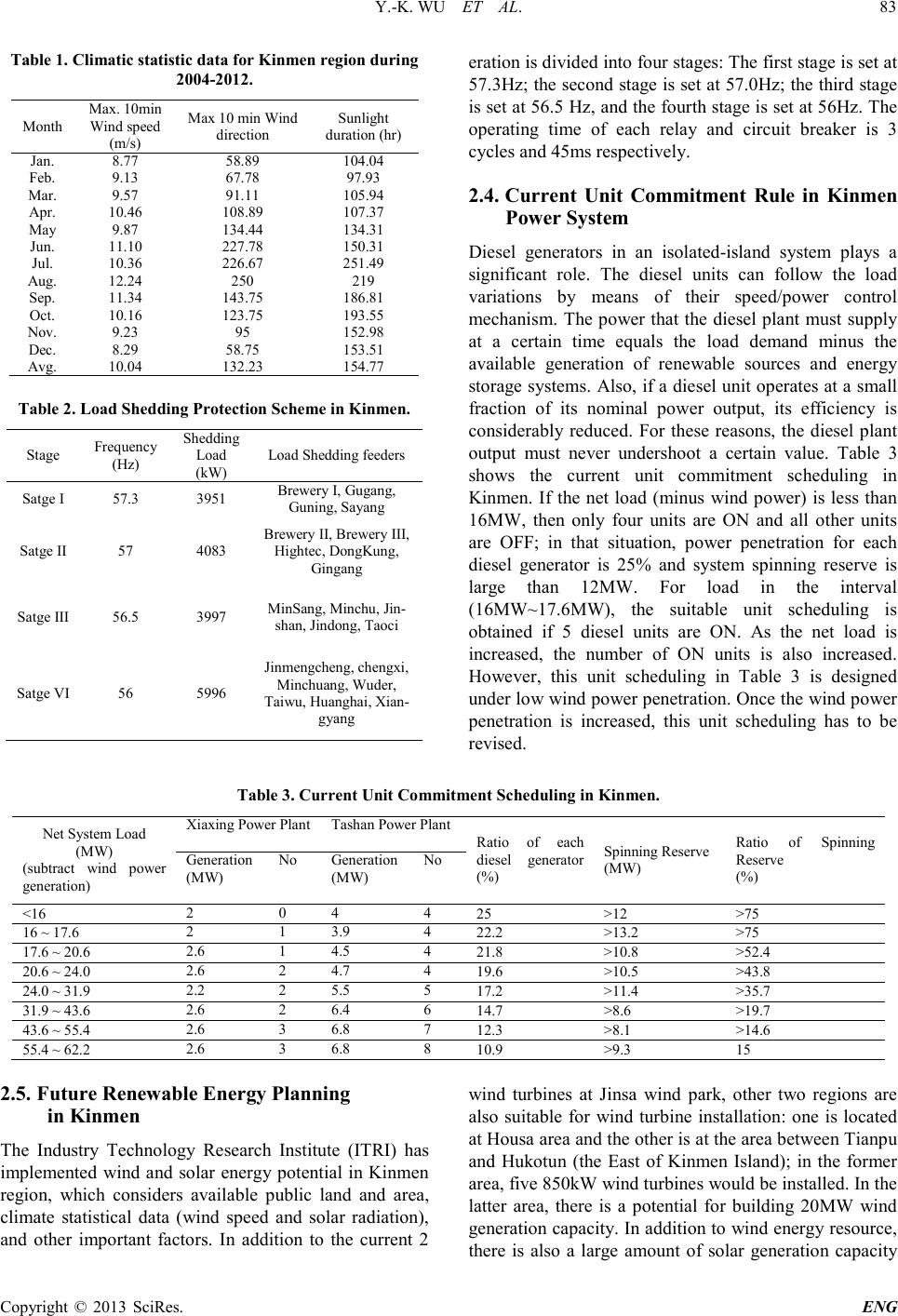 Y.-K. WU ET AL. Copyright © 2013 SciRes. ENG 83 Table 1. C limatic statis t ic data for Ki nmen region d uring 2004-2012. Month Max. 10min Wind speed (m/s) Max 10 min Wind directio n Sunlight duration (hr) Jan. 8.77 58.89 104.04 Feb. 9.13 67.78 97.93 Mar. 9.57 91.11 105.94 Apr. 10.46 108.89 107.37 May 9.87 134.44 134.31 Jun. 11.10 227.78 150.31 Jul. 10.36 226.67 251.49 Aug. 12.24 250 219 Sep. 11.34 143.75 186.81 Oct. 10.16 123.75 193.55 Nov. 9.2 3 95 152.98 Dec. 8.2 9 58.75 153.51 Avg. 10.04 132.23 154.77 Table 2. Load Shedding Protection Scheme in Kinmen . Stage Frequency (Hz) Shedding Load (kW) Load Sh ed din g feeders Sat ge I 57.3 3951 Brewery I, Gugang, Guning, Sayang Sa t g e II 57 4083 B rewery II, B rewery III, Hightec, D o ngKung, Gingang Sa t g e II I 56.5 3997 MinSang , Mi nchu, J i n- shan, J i ndong , T ao c i Satge VI 56 5996 Jinmengcheng, chengxi, Minchuang, Wuder, Taiwu, Huanghai, Xian- gyang eration is di vided into fou r sta ges: The first st a ge i s se t at 57.3Hz; the second stage is set at 57.0Hz; the third stage is set at 56.5 Hz, and the fourth sta ge is se t at 56Hz. The operating time of each relay and circuit breaker is 3 cycles and 45ms respectively. 2.4. Current Unit Commitment Rule in Kinmen Power System Diesel generators in an isolated-island system plays a significant role. The diesel units can follow the load variations by means of their speed/power control mechanism. T he power that the diesel plant must supply at a certain time equals the load demand minus the available generation of renewable sources and energy storage syste ms. Also , if a die sel unit operates at a small fraction of its nominal power output, its efficiency is considerably reduced. For these reasons, the diesel plant output must never undershoot a certain value. Table 3 shows the current unit commitment scheduling in Kinmen. If the net load (minus wind power) is less than 16MW, then only four units are ON and all other units are OFF; in that situation, power penetration for each diesel generator is 25% and system spinning reserve is large than 12MW. For load in the interval (16MW~17.6MW), the suitable unit scheduling is obtained if 5 diesel units are ON. As the net load is increased, the number of ON units is also increased. However, this unit scheduling in Table 3 is designed under low wind power penetration. Once the wind power penetration is increased, this unit scheduling has to be revised. Table 3. Current Unit Commitment Scheduling in Kinmen. Net System Load (MW) (subtract wind power generation) Xiaxing Power Plan t Tashan Power Plant Ratio of each diesel generator (%) Spinning Reserve (MW) Ratio of Spinning Reserve (%) Generation (MW) No Generation (MW) No <16 2 0 4 4 25 >12 >75 16 ~ 17.6 2 1 3.9 4 22.2 >13 .2 >75 17.6 ~ 20.6 2.6 1 4.5 4 21.8 >10.8 >52.4 20.6 ~ 24.0 2.6 2 4.7 4 19.6 >10 .5 >43 .8 24.0 ~ 31.9 2.2 2 5.5 5 17.2 >11.4 >35.7 31.9 ~ 43.6 2.6 2 6.4 6 14.7 >8 .6 >19 .7 43.6 ~ 55.4 2.6 3 6.8 7 12.3 >8.1 >14 .6 55.4 ~ 62.2 2.6 3 6.8 8 10.9 > 9.3 15 2.5. Future Renewable Energy Planning in Kinmen The Industry Technology Research Institute (ITRI) has implemented wind and solar energy potential in Kinmen region, which considers available public land and area, climate statistical data (wind speed and solar radiation), and other important factors. In addition to the current 2 wind turbines at Jinsa wind park, other two regions are also suitable for wind turbine installation: one is located at Housa area and the other is at the area between T ianpu and Hukotun (the East of Kinmen Island); in the former area, five 850kW wind turbines would be installed. In the latter area, there is a potential for building 20MW wind generation capacity. In addition to wind energy resource, there is also a large amount of solar generation capacity  Y.-K. WU ET AL. Copyright © 2013 SciRes. ENG 84 that can be installed in Kinmen Island. Three locations have been planned to install PV panels, including Kin- men airport (272kW), tourist service center (865kW), and Kinmen university (86kW). If all of the planning renewable energy capacity is installed in Kinmen Island, the installed capacity of wind and solar generation is 28.25MW and 1.223MW respectively. Furthermore, energy storage system with 2.5MW capacity is also planned to install in this syste m. 3. System Impacts of Large-Scale Integration of Renewable Energy 3.1. System Inertia and Spinning Reserve Real time system inertia and spinning reserve are the main parameters having influence on operation limits. In particular, the issue of inertia is important for high wind penetration in synchronized systems. System in- ertia can be defined as the total amount of kinetic energy stored in all spinning turbines and rotors in the sys tem. W hen a n unbalance occurs bet ween generation and demand, the inertia would limit the rate of change of frequency. For a given network condition replacing the diesel generation by wind power generation would lead to a reduction in global inertia and spinning re- serve. T his tr anslate s direc tly into lower operatio n li m- its to cope with the frequency stability criterion. Therefore, system operators should review the system inertia performance to adjust the frequency control scheme on seasonal or annual bases. As wind power penetration increases, the system inertia information becomes more important for system operators. Sudden loss of supply or demand will result in fre- que ncy de via tio n fro m the nomi nal freq uenc y. T he rat e of change in frequency due to imbalance depends on the system inertia. System inertia is directly propor- tional to synchronously rotating mass in the system. The general equation for calculating rate of change of frequency using system inertia constant (H) is illu- strated i n (1 ) b e lo w: 0 22 df PD ff dt HH ∆ =⋅ +⋅∆ (1) where H is the system inertia consta nt on system base; D is the power system load d ampening valu e; f0 is the frequency at the time of disturbance; ΔP = (PL-PG)/PG; PL indic ates the load prior to generation loss; PG in- dicate s system generation after loss; Δf is the change i n frequenc y. Assuming load dampening D to be zero, (1) res ul ts in a simplified equation as belo w: 0 2 df P ff dt H ∆ ∆= =⋅ (2) Therefore, the inertia constant H and frequency change ∆ f presents an inverse proportion; that is, as system disturbance occurs, a larger H value would re- sult in smaller freque ncy c ha n ge . 3.2. Limit Criterions of Wind Power Penetration In addition to syste m inertia, the number of on-line die sel generator units and the corresponding spinning reserve margin may also affect the lowest system transient fre- quency. The more diesel generator units running, the larger the corresponding spinning reserve margin is, and the le s s t he d r o p o f the lowes t s yste m t ra ns ie nt fre q ue ncy would be. In other words, to prevent low transient fre- quency from triggering an under-frequency load shed- ding relay as a principle during an incident, the number of running diesel generator units should be increased appropriately. However, the issue of low power genera- tion efficiency and accelerated depreciation when power output of each single generator unit is too low should also be considered. Therefore, a set of appropriate oper- ating modes for diesel generators to meet the system re- liability and economic is important. Generally, the de- termination of the maxi mum wind power penetration will be determined by the following limit criterio ns: minimal and maximu m power production criterion of the co nve n- tional diesel plants, ramp rate of the diesel plants, dy- namic penetration limit for transient frequency and vol- tage stability, power quality impact, and protection schemes and load management. In the c ase of small i sland s ystems, t he sudd en loss o f all available wind power is quite probable. This may happen due to generator trips, grid faults, and voltage sags that exceed the fault ride through capability of the wind turbine ge ne r ato r s, and even due to fast increases of the wind speed that exceeds the wind turbine cut out speed. Tripping wind turbines or diesel u nits will i mpose a substantial frequency excursion in the Kinmen system. Therefore, the transient frequency stability becomes a significant crite rion to evaluate the maxi mum wind po w- er penetration. 3.3. Case Study - the Impact of System Incidents Limit Criterions of Wind Power Penetration In Kinmen ’s case, this dispatch and output arrangement was chosen by mainly considering the tolerance of the reserve margin of the system and the minimum accepta- ble output o f the generator u nits. In the tran sient simula- tion, six systematic perturbations were assumed sepa- rately, including N-1 diesel generator units at Tashan P ower Plant (the maximum output of generator units), trip-off of the Jinsha wind farm, trip-off of the distribu- tion line from Bus 2201 to Bus 2202, trip-off of the dis- 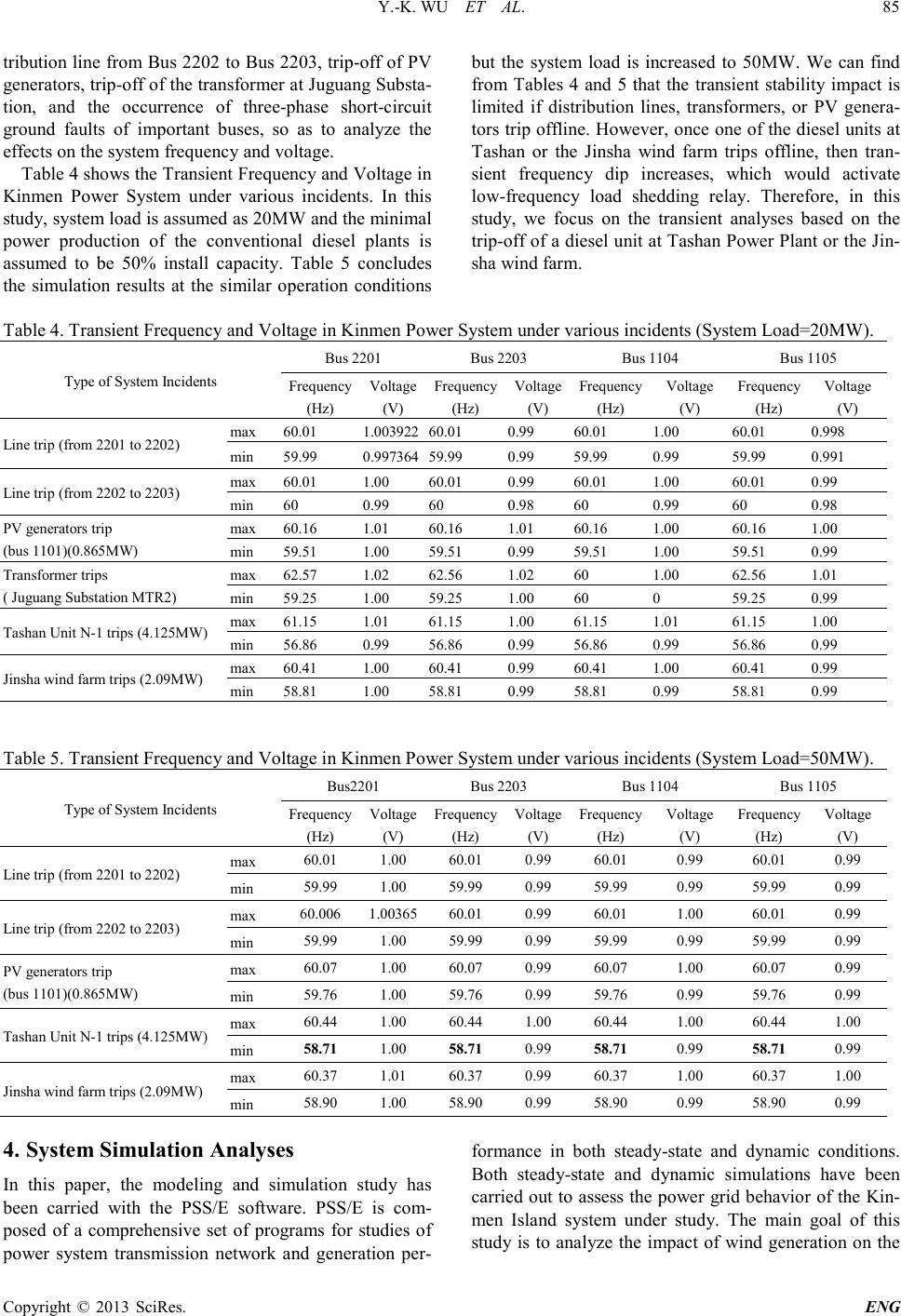 Y.-K. WU ET AL. Copyright © 2013 SciRes. ENG 85 tribution line from Bus 2202 to Bus 2203, trip-off of P V generators, trip -of f o f th e tr an sfo r mer a t Ju guan g Sub sta- tion, and the occurrence of three-phase short-circuit ground faults of important buses, so as to analyze the effects o n the system freq uency and voltage. Ta ble 4 sho ws the T r ansie nt Fr eque ncy and Vol tage i n Kinmen Power System under various incidents. In this study, system load is assumed as 20MW and the minimal power production of the conventional diesel plants is assumed to be 50% install capacity. Table 5 concludes the simulation results at the similar operation conditions but the system load is increased to 50MW. We can find from Tables 4 and 5 that the transient stability impact is limited if distribution lines, transformers, or PV genera- tors trip offline. Ho wever, o nce one o f the diesel units at Tashan or the Jinsha wind farm trips offline, then tran- sient frequency dip increases, which would activate low-frequency load shedding relay. Therefore, in this study, we focus on the transient analyses based on the trip-off of a diesel unit at Tashan Po wer Plant or the Ji n- sha wind fa rm. Table 4. T ransient Fr equency and Voltage in Ki nmen Power System under various incidents (System Load=20MW). Type of System Incidents Bus 2201 Bus 2203 Bus 1104 B us 1105 Frequency (Hz) Voltage (V) Frequency (Hz) Voltage (V) Frequency (Hz) Voltage (V) Frequen cy (Hz) Voltage (V) Li ne trip (from 2201 to 2202) max 60.01 1.003922 60.01 0.99 60.01 1.00 60.01 0.998 min 59.99 0.9973 64 59.99 0.99 59.99 0.99 59.99 0.991 Line trip (from 2202 to 2203) max 60.01 1.00 60.01 0.99 60.01 1.00 60.01 0.99 min 60 0.99 60 0.98 60 0.99 60 0.98 PV generat or s trip (bus 110 1)(0.865MW) max 60.16 1.01 60.16 1.01 60.16 1.00 60.16 1.00 min 59.51 1.00 59. 51 0.99 59.51 1.00 59.51 0.99 Transformer trips ( Juguang Subst ation MTR2) max 62.57 1.0 2 62.56 1.02 60 1.00 62.56 1.01 min 59.25 1.00 59.25 1.00 60 0 59.25 0.99 Tasha n Unit N-1 trips (4.125MW) max 61.15 1.0 1 61.15 1.00 61.15 1.0 1 61.15 1.00 min 56.86 0.99 56.86 0.99 56.86 0.99 56.86 0.99 Jinsha wind farm trips (2.09MW) max 60.41 1.00 60.41 0.99 60.41 1.00 60.41 0.99 min 58.81 1.00 58.81 0.99 58.81 0.99 58.81 0.99 Table 5. Tr ansient F requency a nd Voltage in Kinmen Power System unde r var ious incidents (Sys t em Lo ad= 50MW). Type of System Incidents Bus2201 Bus 2203 Bus 1104 Bus 1105 Frequency (Hz) Voltage (V) Frequency (Hz) Voltage (V) Frequency (Hz) Voltage (V) Frequency (Hz) Voltage (V) Li ne trip (from 2201 to 2202) max 60.01 1.00 60. 01 0.99 60.01 0.99 60.01 0.99 min 59.99 1.00 59.99 0.99 59.99 0.99 59.99 0.99 Line trip (from 2202 to 2203) max 60.006 1.00365 60.01 0.99 60.01 1.00 60. 01 0.99 min 59.99 1.00 59.99 0.99 59.99 0.99 59.99 0.99 PV generat or s trip (bus 110 1)(0.865MW) max 60.07 1.00 60.07 0.99 60.07 1.00 60. 07 0.99 min 59.76 1.00 59.76 0.99 59.76 0.99 59.76 0.99 Tasha n Unit N-1 trips (4.125MW) max 60.44 1.00 60. 44 1.00 60.44 1.00 60.44 1.00 min 58.71 1.00 58.71 0.99 58.71 0.99 58.71 0.99 Jinsha wind farm trips (2.09MW) max 60.37 1.01 60.37 0.99 60.37 1.00 60.37 1.00 min 58.90 1.00 58.90 0.99 58.90 0.99 58.90 0.99 4. System Simulation Analyses In this paper, the modeling and simulation study has been carried with the PSS/E software. PSS/E is com- posed of a comprehensive set of programs for studies of power system transmission network and generation per- formance in both steady-state and dynamic conditions. Both steady-state and dynamic simulations have been carried out to assess the power grid behavior of the Kin- men Island system under study. The main goal of this study is to analyze the impact of wind generation on the 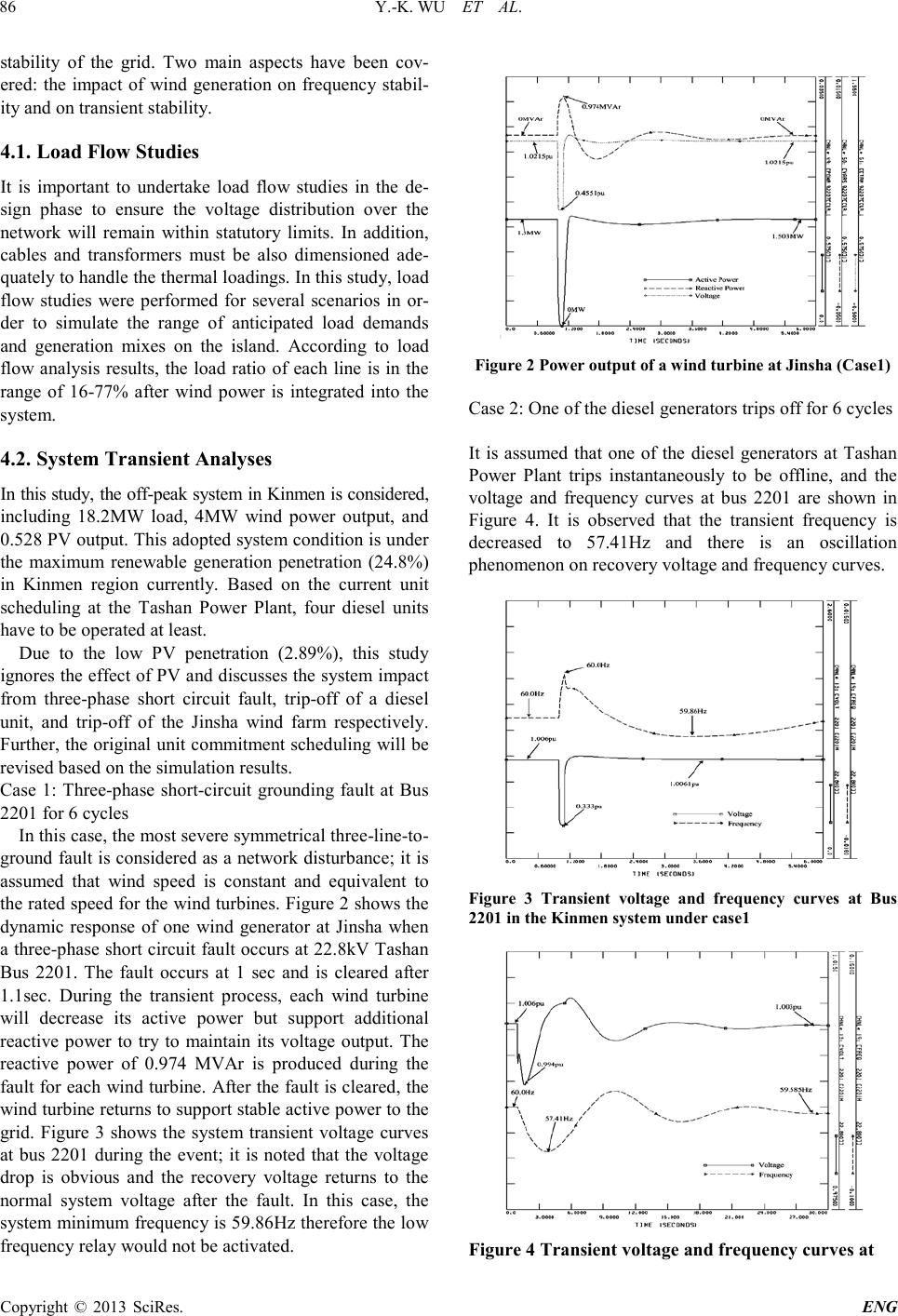 Y.-K. WU ET AL. Copyright © 2013 SciRes. ENG 86 stability of the grid. Two main aspects have been cov- ered: the impact of wind generation on frequency stabil- ity and on transient stability. 4.1. Load Flow Studies It is important to undertake load flow studies in the de- sign phase to ensure the voltage distribution over the network will remain within statutory limits. In addition, cables and transformers must be also dimensioned ade- quately to ha nd le the thermal l o a di ngs. In thi s st udy, load flow studies were performed for several scenarios in or- der to simulate the range of anticipated load demands and generation mixes on the island. According to load flow analysis results, the load ratio of each line is in the range of 16-77% after wind power is integrated into the system. 4.2. System Transient Analyses In this st udy, the off-pea k syste m in Kinmen i s con sidered, including 18.2MW load, 4MW wind power output, and 0.528 PV output. This adopted system condition is under the maximum renewable generation penetration (24.8%) in Kinmen region currentl y. Based on the current unit scheduling at the Tashan Power Plant, four diesel units have to be operated at least. Due to the low PV penetration (2.89%), this study ignor es the e ffec t of PV and d iscusse s the s ystem i mpac t from three-phase short circuit fault, trip-off of a diesel unit, and trip-off of the Jinsha wind farm respectively. Furt her, the o riginal unit co mmitment sc heduli ng will b e revised based on the simulation results. Case 1: Three-phase short-circuit grounding fault at Bus 2201 for 6 cycles In thi s c ase , t he most severe symmetrical three-line-to - ground fault is considered as a network disturbance; it i s assumed that wind speed is constant and equivalent to the rated speed for the wind tur bines. Figure 2 shows t he dynamic response of one wind generator at Jinsha when a three-phase short circuit fault occurs at 22.8kV Tashan Bus 2201. The fault occurs at 1 sec and is cleared after 1.1sec. During the transient process, each wind turbine will decrease its active power but support additional reactive power to try to maintain its voltage output. The reactive power of 0.974 MVAr is produced during the fault for eac h wind turb ine. After the fault is cleared, the wind t urbi ne re tur ns to supp ort stable a ctive po wer to the grid. Figure 3 shows the system transient voltage curves at bus 2201 during the event; it is noted that the voltage drop is obvious and the recovery voltage returns to the normal system voltage after the fault. In this case, the system minimum frequency is 59.86Hz therefore the lo w frequency relay wo uld not be activated. Figure 2 Pow er output of a wind turbi ne at J ins ha (Case1) Case 2: One of the diesel gene r a tors trips o ff for 6 cycles It is assumed that one of the diesel generators at Tashan Power Plant trips instantaneously to be offline, and the voltage and frequency curves at bus 2201 are shown in Figure 4. It is observed that the transient frequency is decreased to 57.41Hz and there is an oscillation phenomenon on recover y voltage and frequency curves. Figure 3 Transient voltage and frequency curves at Bus 2201 in the Kinmen system under case1 Figure 4 Transient voltage and frequency curves at 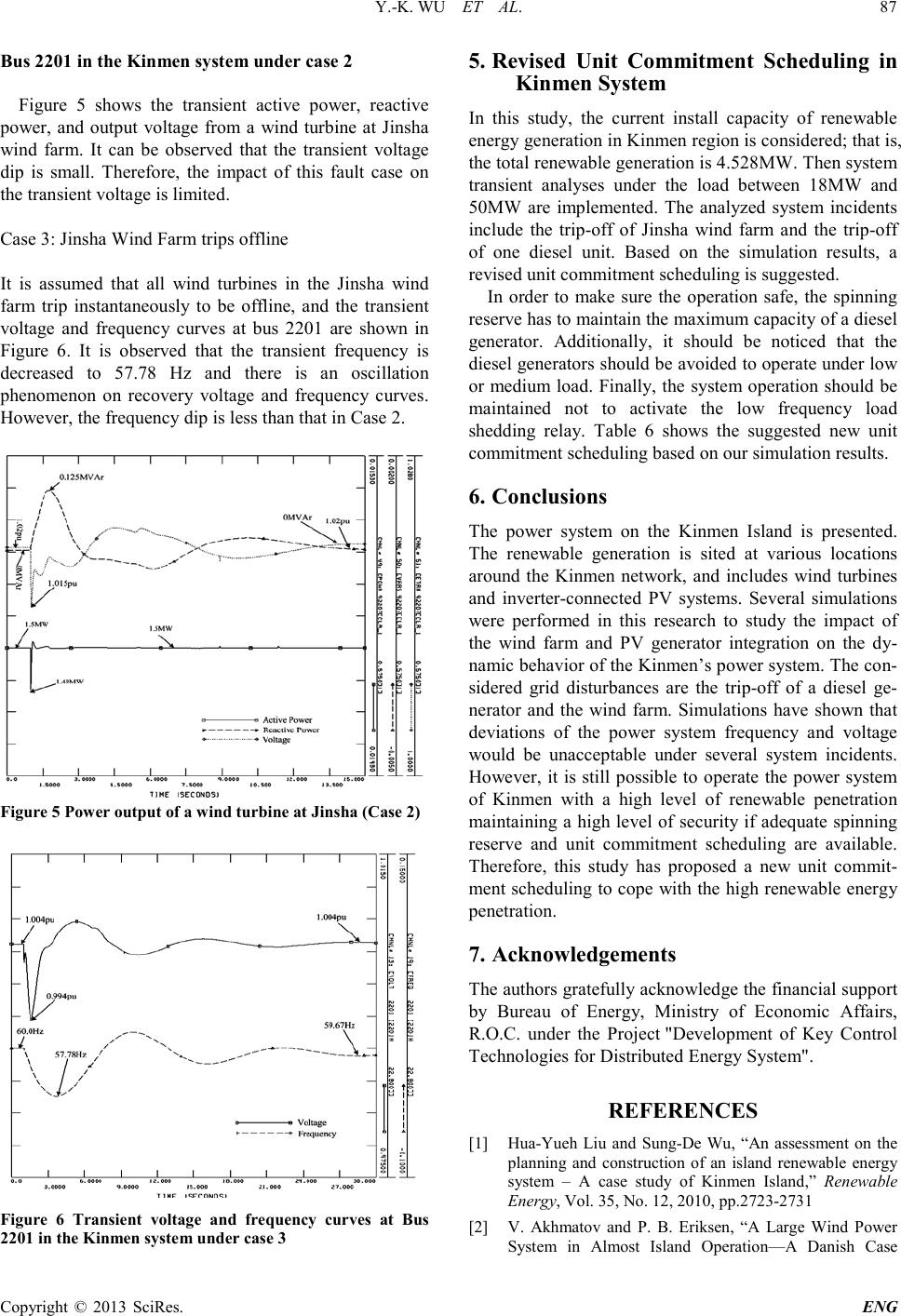 Y.-K. WU ET AL. Copyright © 2013 SciRes. ENG 87 Bus 2201 in the Kinmen system under case 2 Figure 5 shows the transient active power, reactive power, and output voltage from a wind turbine at Jinsha wind farm. It can be observed that the transient voltage dip is small. Therefore, the impact of this fault case on the transient voltage is limited. Case 3: Jinsha Wind Farm trips o ffline It is assumed that all wind turbines in the Jinsha wind farm trip instantaneously to be offline, and the transient voltage and frequency curves at bus 2201 are shown in Figure 6. It is observed that the transient frequency is decreased to 57.78 Hz and there is an oscillation phenomenon on recovery voltage and frequency curves. However , the frequency dip is les s than that in Case 2. Figure 5 Power output of a wind turbine at J ins ha (C ase 2) Figure 6 Transient voltage and frequency curves at Bus 2201 in the Kinmen system under case 3 5. Revised Unit Commitment Scheduling in Kinmen System In this study, the current install capacity of renewable ener gy gene ra tio n i n K i n men r egi on i s cons id er ed ; that i s, the total renewable generation is 4.528MW. Then system transient analyses under the load between 18MW and 50MW are implemented. The analyzed system incidents include the trip-off of Jinsha wind farm and the trip-off of one diesel unit. Based on the simulation results, a revised unit co mmitment scheduling is suggested. In order to make sure the operation safe, the spinning reserve has to maintain the maximum capacity of a diesel generator. Additionally, it should be noticed that the diesel generators should be avoided to operate under low or medium load. Finally, the system operation should be maintained not to activate the low frequency load shedding relay. Table 6 shows the suggested new unit commit ment scheduling based o n our simula t io n results. 6. Conclusions The power system on the Kinmen Island is presented. The renewable generation is sited at various locations around the Kinmen network, and includes wind turbines and inverter-connected PV systems. Several simulations were performed in this research to study the impact of the wind farm and PV generator integration on the dy- namic beha vio r o f the Ki nme n’s po wer syste m. T he con- sidered grid disturbances are the trip-off of a diesel ge- nerator and the wind farm. Simulations have shown that deviations of the power system frequency and voltage would be unacceptable under several system incidents. Ho wever, it is still possible to operate the power system of Kinmen with a high level of renewable penetration maintaining a high level of se curity if adequate spinni ng reserve and unit com mi tment scheduling are available. Therefore, this study has proposed a new unit commit- ment scheduling to cope with the high renewable energ y penetration. 7. Acknowledgements The autho rs gr ate full y ack no wled ge the fi nanc ial s upp or t by Bureau of Energy, Ministry of Economic Affairs, R.O.C. under the Project "Development of Key Control Technologies fo r Distrib uted Ener gy System". REFERENCES [1] Hua-Yueh Liu and Sung-De Wu, “An assessment on the planning and construction of an island renewable energy system – A case study of Kinmen Island,” Renewable Energy, Vol. 35, No. 12, 2010, pp.2723-2731 [2] V. Akhmatov and P. B. Eriksen, “A Large Wind Power System in Almost Island Operation—A Danish Case 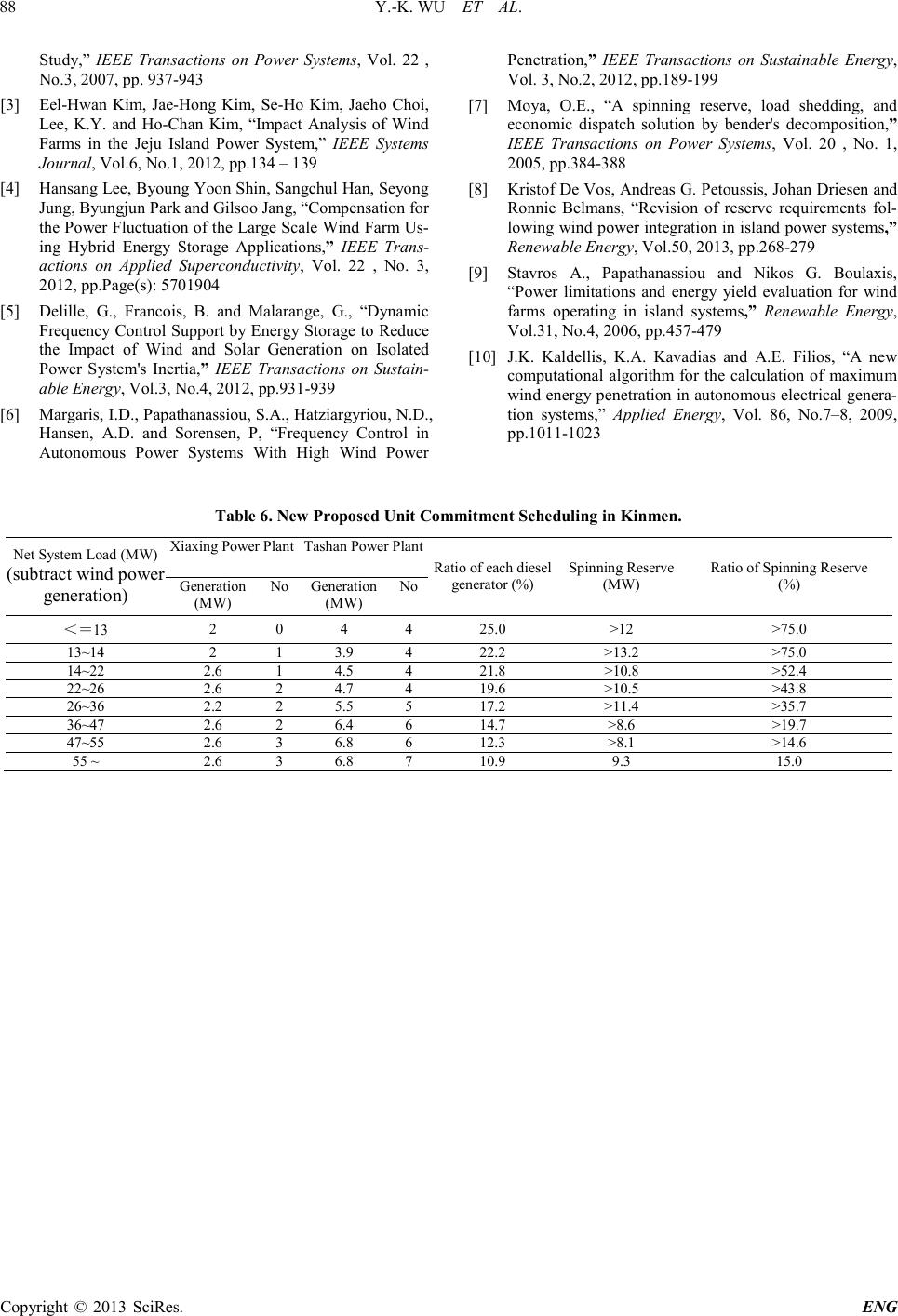 Y.-K. WU ET AL. Copyright © 2013 SciRes. ENG 88 Study,” IEEE Transactions on Power Systems, Vol. 22 , No.3, 2007, pp. 937-943 [3] Eel-Hwan Kim, Jae-Hong Kim, Se-Ho Kim, Jaeho Choi, Lee, K.Y. and Ho-Chan Kim, “Impact Analysis of Wind Farms in the Jeju Island Power System,” IEEE Systems Journal, Vol.6, No.1, 2012, pp.134 – 139 [4] Han sang Lee, Byou ng Y oon Shi n, San gchul Han, Seyong Jung, B yungj un Park and Gil soo J a ng, “Compensation for the Po wer Fluctuation of the Large Scale Win d Farm Us- ing Hybrid Energy Storage Applications,” IEEE Trans- actions on Applied Superconductivity, Vol. 22 , No. 3, 2012, pp.Page(s ): 5 701904 [5] Delille, G., Francois, B. and Malarange, G., “Dynamic Frequency Control Support by Energy Storage to Reduce the Impact of Wind and Solar Generation on Isolated Power System's Inertia,” IEEE Transactions on Sustain- able Energy, Vol .3, No.4, 2 012, pp.931-939 [6] Margaris, I.D., Papathanassiou, S.A., Hatzi arg yriou, N. D., Hansen, A.D. and Sorensen, P, “Frequency Control in Autonomous Power Systems With High Wind Power Penetration,” IEEE Transactions on Sustainable Energy, Vol. 3, No.2, 2012, pp. 189-199 [7] Moya, O.E., “A spinning reserve, load shedding, and economic dispatch solution by bender's decomposition,” IEEE Transactions on Power Systems, Vol. 20 , No. 1, 2005, pp .384-388 [8] Kristo f De Vos, Andreas G. Petoussis, Johan Dri esen and Ronnie Belmans, “Revision of reserve requirements fol- lowing wind power integration in island power systems,” Renewable Energy, Vol.50, 2013, pp.268-279 [9] Stavros A., Papathanassio u and Nikos G. Boulaxis, “Power limitations and energy yield evaluation for wind farms operating in island systems,” Renewable Energy, Vol.31, No.4, 2006, pp.457-479 [10] J.K. Kaldellis, K.A. Kavadias and A.E. Filios, “A new computational algorithm for the calculation of maximum wind energy penetration in autonomous electrical genera- tion systems,” Applied Energy, Vol. 86, No.7–8, 2009, pp.1011-1023 Table 6. New Proposed Uni t Commitment Scheduling in Kinmen. Net System Load (MW) (subtract wind power generation) Xiaxing Power Plan t Tashan Power Plant Ratio of each diesel generator (%) Spinning Reserve (MW) Ratio of Spinni ng Reserve (%) Generation (MW) No Generation (MW) No <=13 2 0 4 4 25.0 >12 >75 .0 13~14 2 1 3.9 4 22.2 >13.2 >75 .0 14~22 2.6 1 4.5 4 21.8 >10.8 >52 .4 22~26 2.6 2 4.7 4 19.6 >10.5 >43 .8 26~36 2.2 2 5.5 5 17.2 >11.4 >35 .7 36~47 2.6 2 6.4 6 14.7 >8.6 >19 .7 47~55 2.6 3 6.8 6 12.3 >8.1 >14 .6 55 ~ 2.6 3 6.8 7 10.9 9.3 15.0 |

